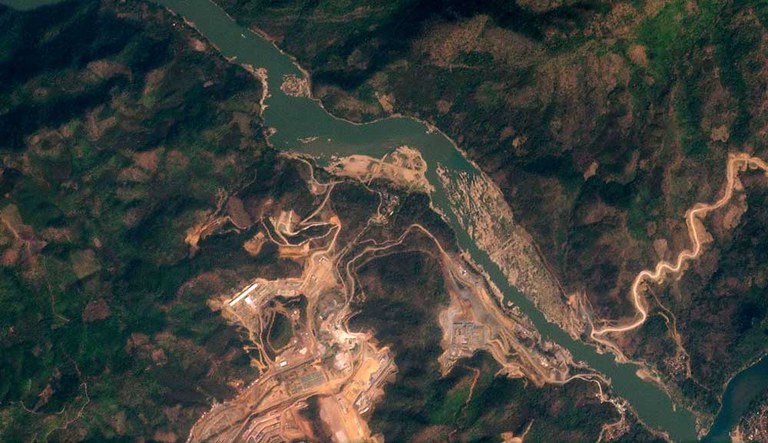Speculation that the historic Lao town of Luang Prabang could be stripped of its World Heritage status because of a massive dam planned upstream is worrying local residents.
Although the Lao government denies there is cause for concern, a former senior UNESCO official has reportedly warned that it’s a real threat hanging over one of the country’s main tourist attractions.
Luang Prabang was named a UNESCO World Heritage Site in 1995 for its “unique, remarkably well-preserved townscape.”
It’s known for its daily parade of monks collecting alms, vibrant night market, well-preserved Buddhist temples, including the 16th-century gilded Wat Xieng Thong, and colonial-era architecture.
Nearly 780,000 foreign and domestic visitors in the first nine months of 2023, according to Lao tourism figures.

Questions about the town’s status arose after Minja Yang, a former deputy director of the UNESCO World Heritage Centre, told Nikkei Asia in January that Luang Prabang was at risk of losing its status because of increasing development related to a hydropower dam project about 25 kilometers (16 miles) upstream on the Mekong River.
In March 2023, UNESCO issued a report recommending that Laos continue efforts to ensure that the Luang Prabang Dam would not have a negative impact on the town’s heritage sites, and take measures to regulate tourism-related activities and infrastructure development.
The US$3 billion, 1,460-megawatt dam project on the Mekong mainstream is located between the upstream Pak Beng hydropower project and the downstream Xayaburi Dam and will provide power for export to Thailand and Vietnam after completion in 2027.
It is one of many dams the Lao government is building along the Mekong River in the country’s quest to become the “battery of Southeast Asia.”

The U.N.’s Paris-based cultural agency requested that Laos submit to the World Heritage Centre an updated report on the state of conservation and the implementation of the measures by Feb. 1, 2024, to preserve the city’s “outstanding universal value.”
“If the second dam is indeed constructed, I believe Luang Prabang should be delisted,” Yang told Nikkei in an email.
“Without the World Heritage status, ill-conceived projects of shopping malls and casinos aimed for certain categories of tourists that we have so far succeeded in stopping over the past 20 years, will now cave into various vested interests,” Yang told Nikkei. “So, I can only imagine what the future of the town will be.”
RFA could not reach Yang or officials in UNESCO’s Bangkok office for comment.
Mixed reactions
An official from the World Heritage Department of the Lao Ministry of Information, Culture and Tourism, who wanted to be identified only by his first name Pheune, told RFA on Feb. 2 that Luang Prabang would not be delisted and that UNESCO officials had expressed concerns outlined in the March 2023 report.
Pheune also said that construction of the Luang Prabang Dam would not affect the town’s World Heritage status because the site is far from the city.
A Luang Prabang province official, who like the other sources in this report requested anonymity for safety reasons, agreed. “To delist the town of Luang Prabang is not easy,” he said.
“Yes, many Chinese are leasing buildings and transforming them to hotels and restaurants, and some of them might not be complying with the rules and regulations of UNESCO, so our city officials should be aware of those issues and should step up the control,” he said.

But other Lao officials and city residents say they are concerned that Luang Prabang might be at risk because of too many Chinese-backed developments, as Chinese investors lease more buildings and turn them into hotels and restaurants.
A Lao businessman in the city said he heard about the delisting rumor, but believes that Luang Prabang is still preserving its heritage, culture, and tradition, especially in the city center.
The development is occurring mainly in the suburbs, and builders must receive permission before erecting structures, he said. The man cited the example of a Chinese company that wants to build a cable car line near the town, though city authorities have not yet given it the green light.
However, a town resident was not so optimistic, noting that Chinese investors in various businesses are not interested in preserving local tradition and culture.
“I heard that Luang Prabang could be stripped of its World Heritage status because there are too many Chinese businesses here,” he told RFA. “Don’t forget, getting World Heritage Site status is not easy. Our government should be careful because Luang Prabang as a World Heritage Site attracts a lot of tourists from around the world. We, the residents, enjoy better living conditions because of that status.”

Another resident raised concern about the future dam.
“What would happen if the dam broke in the future?” he asked about the fate of Luang Prabang, which lies in a valley at the confluence of the Mekong and Nam Khan rivers. “Certainly, that break would wreak havoc on our town and people.”
Phakhanxay Sikhanxay, director general of the Heritage Department under the Ministry of Information, Culture, and Tourism, issued a statement in December, saying that a rumor that UNESCO would remove the city was unfounded and that Laos has not received any official documents about the matter, the Vientiane Times reported.






